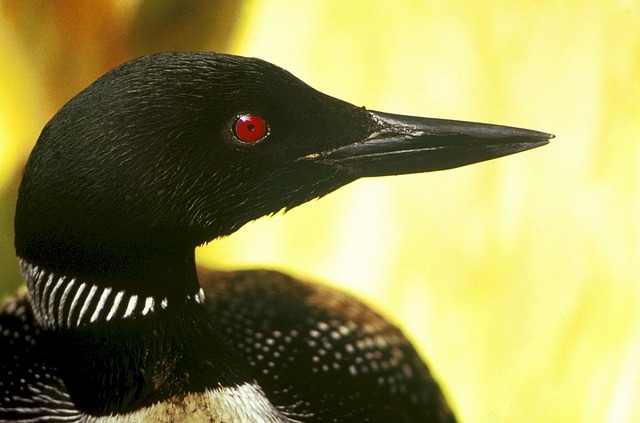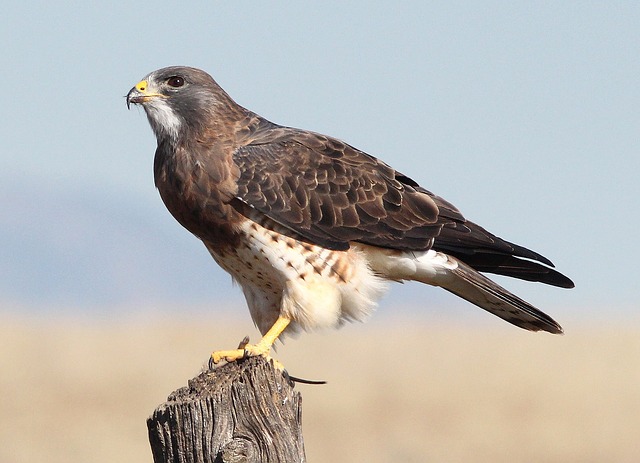Common Loon
A multi-year study of this rare nesting species in Wyoming was conducted by Biodiversity Research Group in partnership with the Wyoming Game & Fish Department, Yellowstone National Park, Grand Teton National Park, and the Forest Service.
Nature Mappers recorded loons they see throughout the year, especially pairs observed during June-August. Those who traveled to remote mountain areas, checked lakes for loons. This study was funded by the Ricketts Conservation Foundation.

Raptors Around Blacktail Butte
Biologists with Craighead Beringia South monitored the raptor community on and around Blacktail Butte to continue a dataset that spans nearly 70 years. Frank and John Craighead first surveyed this study area in the 1940’s and published their work in the book, “Hawks, Owls, and Wildlife” which is still considered a definitive text on raptors and raptor ecology.
CBS biologists wanted to compare the current density and diversity of raptors with the historically collected information to better understand the long-term health of Jackson Hole’s most popular avian guild with the help of citizen scientists. They asked Nature Mappers to submit all sightings of raptors spotted one spring and summer near Blacktail Butte, in the river bottom from Meadow Road north to Moose and in the sagebrush between, to help them locate as many nesting raptors as possible.

Black Rosy-Finch
The Black Rosy-finch nests in high alpine areas of western Wyoming, but we have little information on distribution of this species or documented nesting areas. Nature Mappers who traveled in the mountains above treeline were asked to record of any of these beautiful birds. They also asked to hear about any feeders where they appear in the spring prior to the nesting season.
The hope of this nature mapping exercise was to get a more formal study funded in the future.

Photo: Christopher Taylor
Pika Project
Pikas (Ochotona princeps) are the smallest member of the rabbit family. While small in size, however, they have a lot to say about warm temperatures and icy winters. Pikas are adapted to cool alpine environments and occupy a very narrow thermal niche. In other words, they are physiologically incapable of dealing with warm temperatures. High temperatures (80°F ambient temperature) can be lethal to pikas in as little as six hours if they are unable to find cool interstitial spaces in the talus. Pikas have also been found to be sensitive to extremely cold temperatures, possibly a result of reduced snow depths at lower elevation sites. Little is known about pika distributions in Wyoming and the environmental factors that may affect their persistence. Because of their sensitivity to temperature, high detectability and habitat preferences, pikas are excellent indicator species for evaluating biological impacts of environmental change.
The Meg & Bert Raynes Wildlife Fund, Teton Science Schools and Nature Mapping did a study to better understand how pikas are dealing with a changing thermal landscape. Nature Mappers helped to develop a better understanding of pika distributions in the Greater Yellowstone Ecosystem by reporting pika observations under the guidance of Embere Hall.

Crow and Magpie Nests
Rhea Esposito was a doctoral candidate in the University of Louisiana at Lafayette’s Environmental and Evolutionary Biology program. She worked on the following studying in the Jackson area one summer:
A key feature of understanding animal communities and the ecological roles of individual species involves describing species relationships. Nesting associations are a unique type of relationship where two species are spatially associated during the breeding season. The predator protection hypothesis provides an explanation for why less aggressive or smaller species may form nesting associations with more aggressive or larger species. This hypothesis is primarily focused on the protective benefits to the smaller species, however the costs to the protected species and the positive or negative influence of nesting associations on the protector species are rarely considered.
American crows (Corvus brachyrhynchos) and black-billed magpies (Pica hudsonia) are known to exhibit nesting associations with other members of their species based on ecological factors such as territory quality or threat of nest predation, however nesting associations between these species, termed hetero-specific, have not been previously recorded. Both are behaviorally flexible, generalist omnivores that overlap in their ecological roles and who have been widely studied for their problem-solving skills. Despite their similarities, magpies are approximately half the size of crows, and thus may be more vulnerable to nest predation.
Her PhD project assessed the applicability of the predator protection hypothesis to magpies and crows nesting in Jackson Hole, WY.

Northern Flying Squirrels
The Raynes Wildlife Fund has awarded grants to a number of projects, including one that documented the distribution and habitat attributes of northern flying squirrels in Teton County.
Northern flying squirrels serve as excellent indicators of forest function and health. In Teton County, surveys have not been done and little is known about distribution or habitat use. Surveys will allow us to develop a baseline occupancy model, and evaluate vegetative composition and structure important for this species. Data from Jackson complemented data being collected elsewhere in Wyoming.
Northern flying squirrels are an ecological indicator of older aged forests. No studies have addressed flying squirrel occupancy and habitat requirements in the Jackson area. The results of this study were used to improve our understanding of the status of the species in the Jackson area as well as provide much needed information on habitat use and requirements in this changing ecosystem.

Photo Credits:
Henry Holdsworth
Mark Gocke
Steve Morriss
Sava Malachowski
Leine Stikkel
Tim Griffith
Jon Mobeck
Jackson Hole Wildlife Foundation
Office Location:
25 S. Willow St., Suite 10
Jackson, WY 83001
Mailing Address:
PO Box 8042
Jackson, WY 83002
All rights reserved.
Privacy Policy

